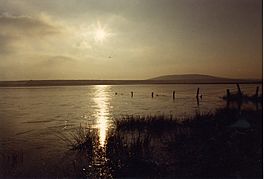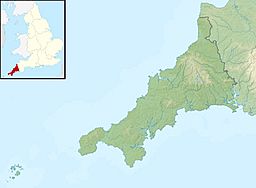Dozmary Pool facts for kids
Quick facts for kids Dozmary Pool |
|
|---|---|

Dozmary Pool
|
|
| Location | Bodmin Moor, Cornwall |
| Coordinates | 50°32′32″N 4°33′01″W / 50.5423°N 4.5502°W |
| Basin countries | United Kingdom |
| Surface area | 14.9 ha (37 acres) |
| Shore length1 | 1.5 km (0.93 mi) |
| Surface elevation | 268 m (879 ft) |
| Islands | none |
| 1 Shore length is not a well-defined measure. | |
Dozmary Pool is a small lake located on Bodmin Moor in Cornwall, UK. It is part of the civil parish of Altarnun. The lake is about 16.9 kilometers (10.5 miles) from the sea. It lies roughly 15 kilometers (9.3 miles) northeast of Bodmin and 2 kilometers (1.2 miles) south of Bolventor.
Dozmary Pool formed after the last Ice Age, during a time called the Holocene period. Water flows out of the pool into Colliford Lake. This makes Dozmary Pool one of the starting points for the River Fowey. In the past, people spelled its name differently, like Dozmaré or Dosmery Pool.
In the late 1800s, a writer named Sabine Baring-Gould said the pool was full of fish. He also noted that many tools from the Stone Age were found around it. These tools showed that people used to work with flint there long ago.
The pool and the land around it are very special. In 1951, the area was named a Site of Special Scientific Interest (SSSI). This was because of its amazing plants and animals. It is also part of the Cornwall Area of Outstanding Natural Beauty. This means the area is protected for its beautiful natural scenery.
Wildlife and Plants
Dozmary Pool is a special kind of lake called an oligotrophic pool. This means its water has low levels of nutrients. It is important for studying the history of plants. Scientists can learn about the vegetation since the last ice-age by looking at pollen found in the lake's mud. This study is called Palynology. The pool is part of a group of sites in southwest England used to understand how plants have changed over time.
A unique plant called spring quillwort (Isoetes echinospora) grows on the fine granite gravel at the bottom of the pool. When the SSSI was first set up in 1951, this was the only place in Cornwall where it was known to grow. However, since 1988, it has been found in three other nearby pools. Another rare plant, six-stamened waterwort (Elatine hexandra), grows along the edges of the pool. This plant is considered nationally scarce in the UK.
A long time ago, a writer named Richard Carew described Dozmary Pool. He said it was about 1.6 kilometers (1 mile) around and no deeper than 2.7 meters (9 feet). He also wrote about some local gentlemen who tried to find fish in the pool. They only found eels. The pool is also home to some rare tiny creatures. These include a type of water flea called Drepanothrix dentate and a small crustacean called Diaptomus vierzejskii. Both of these can be found in large numbers here.
In 1951, when the SSSI was created, Dozmary Pool was a key spot for birds in winter. Many migrating wildfowl, like Eurasian coot (Fulica atra), Eurasian teal (Anas crecca), and Eurasian wigeon (A penelope), would visit. However, since the Siblyback and Colliford reservoirs were built on Bodmin Moor, Dozmary Pool has become less important for these birds. Still, many birds breed around the pool. These include the Eurasian curlew (Numenius arquata), dunlin (Calidris alpina), northern lapwing (Vanellus vanellus), common snipe (Gallinago gallinago), and European stonechat (Saxicola torquate).
Legends and Stories
Dozmary Pool is famous for its connection to old legends. Many people believe it is the home of the Lady of the Lake. According to the legend of King Arthur, it was here that Arthur went by boat to meet the Lady of the Lake. She then gave him his magical sword, Excalibur. The pool is also said to be the place where Bedivere returned Excalibur. This happened as King Arthur was dying after the Battle of Camlann.
Another well-known story about Dozmary Pool is about a man named Jan Tregeagle. In this tale, Tregeagle made a deal with the Devil to gain money and power. When his life ended, he was sent to the bottom of Dozmary Pool as a punishment. It is said that his ghost can still be heard howling across the moor today. The legend says he was given the impossible task of emptying the pool using a leaky limpet shell. He tried to escape to Roche Rock before being given another difficult task.
Fun Activities
For many years, Dozmary Pool was a popular spot for Sunday School trips. Children from the Bolventor Methodist chapel would often visit the lake for their outings.


